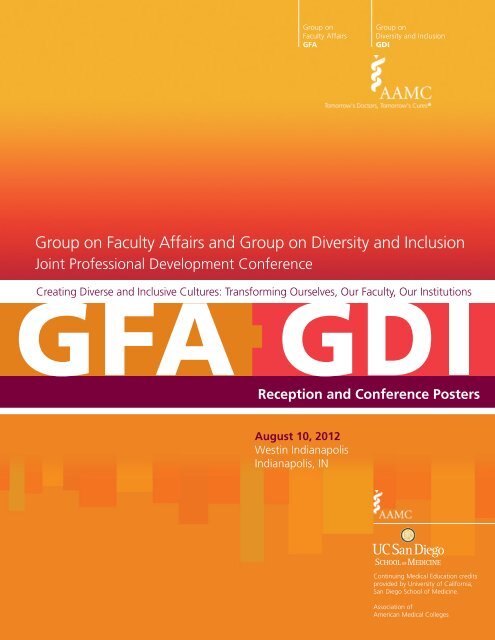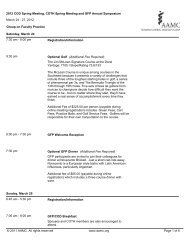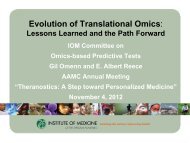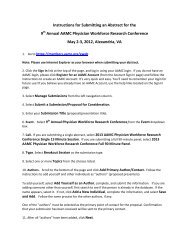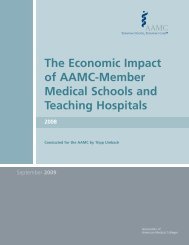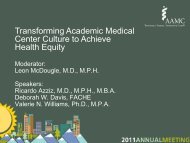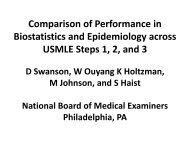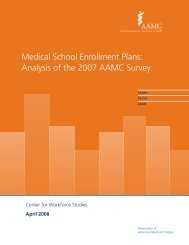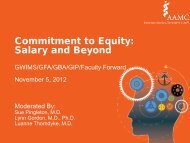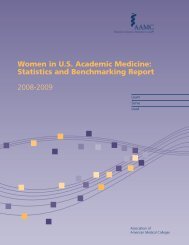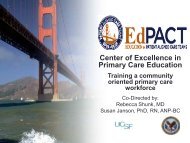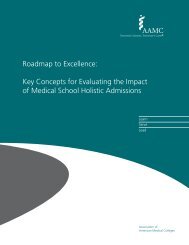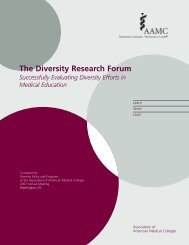here to download - AAMC's member profile
here to download - AAMC's member profile
here to download - AAMC's member profile
- No tags were found...
Create successful ePaper yourself
Turn your PDF publications into a flip-book with our unique Google optimized e-Paper software.
Group on<br />
Faculty Affairs<br />
GFA<br />
Group on<br />
Diversity and Inclusion<br />
GDI<br />
Group on Faculty Affairs and Group on Diversity and Inclusion<br />
Joint Professional Development Conference<br />
Creating Diverse and Inclusive Cultures: Transforming Ourselves, Our Faculty, Our Institutions<br />
Reception and Conference Posters<br />
August 10, 2012<br />
Westin Indianapolis<br />
Indianapolis, IN<br />
Continuing Medical Education credits<br />
provided by University of California,<br />
San Diego School of Medicine.<br />
Association of<br />
American Medical Colleges
2012 GFA/GDI Joint Professional Development Conference<br />
Creating Diverse and Inclusive Cultures:<br />
Transforming Ourselves, Our Faculty, Our Institutions<br />
GFA/GDI Reception and Conference Posters<br />
August 10, 2012, 5:00 pm<br />
Westin Indianapolis Hotel, Grand 5<br />
Dear GFA and GDI colleagues:<br />
Welcome <strong>to</strong> Indianapolis!<br />
Health care in the United States is in an era demanding extensive and intensive reform <strong>to</strong> improve<br />
health care outcomes for diverse populations. To achieve excellence in health care delivery and medical<br />
education, academic health centers need <strong>to</strong> transform by building diverse and well functioning teams.<br />
These teams must successfully address the full spectrum of educational, research, and clinical care<br />
activities.<br />
The 2012 GFA/GDI Poster Session and Welcome Reception highlights the creative collaborations at<br />
academic medical centers by bringing <strong>to</strong>gether two AAMC professional groups critical <strong>to</strong> academic<br />
medicine’s needed transformation. This poster booklet shows some of the most intriguing and<br />
informative information sharing at this conference from the posters accepted for display. This year we<br />
had a record number of poster submissions, a signal of the tremendous amount of collaborative efforts<br />
already happening <strong>to</strong> trigger transformation of attitudes, skills, and competencies needed <strong>to</strong> transform<br />
ourselves, our faculty, and our institutions.<br />
During the reception, we encourage you <strong>to</strong> peruse the posters and engage those presenting each<br />
poster. Remarks from our hosts at the Indiana University School of Medicine will be delivered at the<br />
start of the session <strong>to</strong> optimize your chance <strong>to</strong> gain the most from the posters. This will be a wonderful<br />
opportunity <strong>to</strong> meet and network with new colleagues who have similar interests. We hope you<br />
and your colleagues will leave energized with new ideas for collaborations <strong>to</strong> educate <strong>to</strong>morrow’s<br />
professionals, craft innovative clinical programs, and discover new knowledge <strong>to</strong> improve the health of<br />
all. Posters will remain on display throughout the conference.<br />
Enjoy learning and networking!<br />
Sincerely,<br />
Rob Rockhold, Ph.D.<br />
Chair, Group on Faculty Affairs Professional Development and<br />
Program Planning Subcommittee<br />
Deputy Chief Academic Officer<br />
University of Mississippi School of Medicine<br />
David Acosta, M.D., FAAFP<br />
Chair, AAMC Group on Diversity and Inclusion<br />
Chief Diversity Officer<br />
Direc<strong>to</strong>r, Center for Equity, Diversity and Inclusion<br />
Clinical Professor, Department of Family Medicine<br />
University of Washing<strong>to</strong>n School of Medicine<br />
i<br />
Association of American Medical Colleges, 2012
GFA/GDI Joint Professional<br />
Development Conference<br />
Reception and Conference Posters<br />
Table of Contents<br />
Poster<br />
Board<br />
1. Low-Cost Interactive Forums for Women Faculty Offered by the<br />
Johns Hopkins University School of Medicine’s Office of Women in<br />
Science and Medicine (OWISM)...................................................................... 1<br />
2. The Leadership Program for Women Faculty (LPWF) of the<br />
Johns Hopkins University School of Medicine’s Office of Women in<br />
Science and Medicine (OWISM)...................................................................... 1<br />
3. Setting the Stage for Success: Creation of a Learning Community <strong>to</strong><br />
Foster Faculty Diversity at Two New Medical Schools....................................... 2<br />
4. The Application of Glassick’s Teaching Principles in the Service-Learning<br />
Environment: The Martin Luther King Day of Service....................................... 2<br />
5. An Outcome-Driven, Promotion-Oriented Men<strong>to</strong>ring Program for<br />
Women, Hispanic and URM Faculty: Results of a Pilot Program at a<br />
Newly-Established Medical School.................................................................. 3<br />
6. The Participation of Women, Hispanic and Underrepresented Minority<br />
Faculty in a Structured, Moni<strong>to</strong>red and Comprehensive Faculty<br />
Development Program.................................................................................... 3<br />
7. An Innovative and Inclusive Approach <strong>to</strong> Promoting Faculty<br />
Diversity and Excellence.................................................................................. 4<br />
8. Revisiting the Practitioner-Teacher Model at Rush University............................ 5<br />
9. Exploring the Relationship between Faculty Effort Devoted <strong>to</strong><br />
Clinical Care and Retention............................................................................ 6<br />
10. Part-Time Faculty in Academic Medicine......................................................... 7<br />
11. The “Mid-Career Award”: A Tool <strong>to</strong> Assist Senior Research<br />
Faculty Reinvent Themselves <strong>to</strong> Maintain Vitality and their<br />
Contributions <strong>to</strong> their Institution.................................................................... 8<br />
12. Who Is Your Public Using Communication Strategies <strong>to</strong> Engage<br />
Faculty in Development Opportunities............................................................ 9<br />
13. Advancing Women in Medicine and Science at Indiana University<br />
School of Medicine: Vision, Methods, and Outcomes..................................... 9<br />
14. Optimizing the Practice of Men<strong>to</strong>ring: An Online Curriculum for the<br />
Professional Development of Research Men<strong>to</strong>rs............................................ 10<br />
15. Faculty Diversity: Myths and Realities............................................................ 11<br />
16. Faculty Scholarship Roadblocks..................................................................... 11<br />
17. Identifying Men<strong>to</strong>ring “Best-Practices” for Medical School Faculty................ 12<br />
18. Tenure and Promotion Process Using SharePoint ® Technology ~<br />
Impact on Faculty Participation..................................................................... 13<br />
iii<br />
Association of American Medical Colleges, 2012
GFA/GDI Joint Professional<br />
Development Conference<br />
Reception and Conference Posters<br />
19. Faculty Database: Integrating and Utilizing Information of<br />
Faculty across the Institution......................................................................... 13<br />
20. Preparing the Next Generation: Columbia University/NYP Faculty<br />
Leadership Academy.................................................................................... 14<br />
21. A Model for Leadership and Management Training for Mid-Career<br />
and Senior Women Faculty at Columbia University’s College of<br />
Physicians and Surgeons............................................................................... 14<br />
22. Fostering Diversity through Collaboration at Washing<strong>to</strong>n University<br />
Medical Center............................................................................................. 15<br />
23. BxSHOP: A Comprehensive Health Careers Educational Pathway and<br />
Community Partnership................................................................................ 15<br />
24. Writing More through Peer-Men<strong>to</strong>ring: Developing and Implementing<br />
a Writing Accountability Group within a Faculty Men<strong>to</strong>ring Program............ 16<br />
25. Partnering in Faculty Affairs Research: The Process and Outcomes<br />
for GFA Collaborative Proposals.................................................................... 16<br />
26. Emory University: Creating a Diverse and Inclusive Culture by<br />
Transforming Our Institution......................................................................... 17<br />
27. Departmental Career Advancement Initiatives: The Career<br />
Development and Research Office Model..................................................... 17<br />
iv<br />
Association of American Medical Colleges, 2012
GFA/GDI Joint Professional<br />
Development Conference<br />
Reception and Conference Posters<br />
1.<br />
Low-Cost Interactive Forums for Women Faculty Offered by the Johns Hopkins<br />
University School of Medicine’s Office of Women in Science and Medicine (OWISM)<br />
Author(s):<br />
Barbara Fivush, M.D.<br />
Associate Dean of Women in Science and Medicine<br />
Direc<strong>to</strong>r of the Office of Women in Science and Medicine<br />
Professor of Pediatrics<br />
Division Chief, Pediatric Nephrology<br />
Johns Hopkins University School of Medicine<br />
Lori Grover, O.D.<br />
Assistant Professor, Ophthalmology<br />
Johns Hopkins University School of Medicine<br />
Kari Bass<br />
Johns Hopkins University School of Medicine<br />
In response <strong>to</strong> identified institutional gender inequities, The Office of Women in Science<br />
and Medicine of the JHU School of Medicine developed a drop-in program for female<br />
faculty consisting of “Information & Conversation (I&C) Sessions” offered throughout<br />
the year in order <strong>to</strong> assist women with issues related <strong>to</strong> professional development. We<br />
report on the program’s development and provide an assessment of the early years of<br />
this low-cost initiative targeting women in medicine.<br />
2.<br />
The Leadership Program for Women Faculty (LPWF) of the Johns Hopkins University<br />
School of Medicine’s Office of Women in Science and Medicine (OWISM)<br />
Author(s):<br />
Lori Grover, O.D.<br />
Assistant Professor, Ophthalmology<br />
Johns Hopkins University School of Medicine<br />
Barbara Fivush, M.D.<br />
Associate Dean of Women in Science and Medicine<br />
Direc<strong>to</strong>r of the Office of Women in Science and Medicine<br />
Professor of Pediatrics<br />
Division Chief, Pediatric Nephrology<br />
Johns Hopkins University School of Medicine<br />
Linda Dillon Jones, Ph.D.<br />
Interim Assistant Dean for Faculty Development and Equity<br />
Johns Hopkins University School of Medicine<br />
In response <strong>to</strong> identified institutional gender inequities, The Leadership Program for<br />
Women Faculty (LPWF) was developed <strong>to</strong> assist females at the Johns Hopkins University<br />
School of Medicine overcome barriers <strong>to</strong> career advancement and professional<br />
development. We report on this new longitudinal cohort program’s evolution, and<br />
provide an assessment of the positive outcomes achieved in meeting the objectives of<br />
the Office of Women in Science and Medicine.<br />
1<br />
Association of American Medical Colleges, 2012
GFA/GDI Joint Professional<br />
Development Conference<br />
Reception and Conference Posters<br />
3.<br />
Setting the Stage for Success: Creation of a Learning Community <strong>to</strong> Foster<br />
Faculty Diversity at Two New Medical Schools<br />
Author(s):<br />
Linda H. Gillum, Ph.D.<br />
Associate Dean of Academic Affairs, Faculty Development, and Diversity<br />
Oakland University William Beaumont School of Medicine<br />
Vonda Kaye Douglas-Nikitin, M.D.<br />
Assistant Dean<br />
Oakland University William Beaumont School of Medicine<br />
Jocelyn Ann Mitchell-Williams, M.D., Ph.D.<br />
Associate Dean for Multicultural and Community Affairs<br />
Cooper Medical School of Rowan University<br />
Annette Columbia Reboli, M.D.<br />
Vice Dean and Senior Associate Dean for Faculty Affairs<br />
Cooper Medical School of Rowan University<br />
An approach <strong>to</strong> the recruitment and retention of underrepresented faculty<br />
taken collaboratively by two new and emerging medical schools.<br />
4.<br />
The Application of Glassick’s Teaching Principles in the Service-Learning<br />
Environment: The Martin Luther King Day of Service<br />
Author(s):<br />
Linda H. Gillum, Ph.D.<br />
Associate Dean of Academic Affairs, Faculty Development, and Diversity<br />
Oakland University William Beaumont School of Medicine<br />
Nelia M. Afonso, M.D.<br />
Assistant Dean – Community Integration and Outreach<br />
Oakland University William Beaumont School of Medicine<br />
Lynda Misra, D.O.<br />
Associate Dean Undergraduate Clinical Education<br />
Oakland University William Beaumont School of Medicine<br />
The application of Glassick’s teaching principles in the service learning<br />
environment. Medical students in the community performing health<br />
assessments in conjunction with Martin Luther King Day.<br />
2<br />
Association of American Medical Colleges, 2012
GFA/GDI Joint Professional<br />
Development Conference<br />
Reception and Conference Posters<br />
5.<br />
An Outcome-Driven, Promotion-Oriented Men<strong>to</strong>ring Program for Women,<br />
Hispanic and URM Faculty: Results of a Pilot Program at a Newly-Established<br />
Medical School<br />
Author(s):<br />
Hoi Ho, M.D.<br />
Associate Dean Faculty Affairs & Development<br />
Texas Tech University Health Sciences Center Paul L. Foster School of Medicine<br />
Lorenzo B. Aragon, M.D.<br />
Associate Professor of Family and Community Medicine<br />
Texas Tech University Health Sciences Center Paul L. Foster School of Medicine<br />
Jose Manuel de la Rosa, M.D.<br />
Founding Dean and Vice President for Health Affairs<br />
Texas Tech University Health Sciences Center Paul L. Foster School of Medicine<br />
Veronica Greer, M.D.<br />
Assistant Professor of Emergency Medicine<br />
Texas Tech University Health Sciences Center Paul L. Foster School of Medicine<br />
Jorge Sarmien<strong>to</strong>, M.D.<br />
Assistant Professor of Radiology<br />
Texas Tech University Health Sciences Center Paul L. Foster School of Medicine<br />
Women, Hispanic, and underrepresented minority (URM) faculty are known <strong>to</strong><br />
lag behind the other faculty in achieving scholarly activities that are essential<br />
for tenure-promotion. To address the disparity, the Office of Faculty Affairs &<br />
Development developed a promotion-oriented men<strong>to</strong>ring program at the Paul<br />
L. Foster SOM (PLFSOM), a newly-established medical school. This structured<br />
men<strong>to</strong>ring program requires the mentee <strong>to</strong> fulfill four objectives during the<br />
12-month partnership. The majority of faculty mentees successfully achieved<br />
the objectives.<br />
6.<br />
The Participation of Women, Hispanic and Underrepresented Minority Faculty<br />
in a Structured, Moni<strong>to</strong>red and Comprehensive Faculty Development Program<br />
Author(s):<br />
Hoi Ho, M.D.<br />
Associate Dean Faculty Affairs & Development<br />
Texas Tech University Health Sciences Center Paul L. Foster School of Medicine<br />
Ogechika Alozie, M.D., M.P.H., AAHIVS<br />
Assistant Professor of Medicine<br />
Texas Tech University Health Sciences Center<br />
Lorenzo B. Aragon, M.D.<br />
Associate Professor of Family and Community Medicine<br />
Texas Tech University Health Sciences Center Paul L. Foster School of Medicine<br />
3<br />
Association of American Medical Colleges, 2012
GFA/GDI Joint Professional<br />
Development Conference<br />
Reception and Conference Posters<br />
Jose Manuel de la Rosa, M.D.<br />
Founding Dean and Vice President for Health Affairs<br />
Texas Tech University Health Sciences Center Paul L. Foster School of Medicine<br />
Jorge Sarmien<strong>to</strong>, M.D.<br />
Assistant Professor of Radiology<br />
Texas Tech University Health Sciences Center Paul L. Foster School of Medicine<br />
The Office of Faculty Affairs & Development (OFAD) developed a program<br />
for faculty <strong>to</strong> enrich their career development capabilities, and <strong>to</strong> enhance<br />
skills in teaching and assessing learners. Giving priority <strong>to</strong> women, Hispanic<br />
and under-represented minority (URM) faculty, OFAD engaged them in<strong>to</strong><br />
the Faculty Development Course (FDC), a 90-hour comprehensive program.<br />
Intervention outcomes showed that FDC has contributed significantly <strong>to</strong> the<br />
successful career development of the participants and <strong>to</strong> the promotion of<br />
the institutional diversity.<br />
7.<br />
An Innovative and Inclusive Approach <strong>to</strong> Promoting Faculty Diversity and<br />
Excellence<br />
Author(s):<br />
Wanda Lipscomb, Ph.D.<br />
Senior Associate Dean for Diversity and Inclusion<br />
Associate Dean for Student Affairs<br />
Associate Professor and Psychiatry<br />
Michigan State University College of Human Medicine<br />
Donna D. Mulder<br />
Direc<strong>to</strong>r<br />
Michigan State University College of Human Medicine<br />
William Charles Wadland, M.D., M.S.<br />
Professor and Chair, Department of Family Medicine<br />
Associate Dean for Faculty Affairs/Development<br />
Michigan State University College of Human Medicine<br />
Michigan State University has designated for each College a Faculty<br />
Excellence Advocate as a part of the ADAPP-ADVANCE initiative. MSU<br />
College of Human Medicine has expanded this and established a Faculty<br />
Excellence Team including the Associate Deans for Diversity and Inclusion,<br />
Faculty Affairs and Development, Research and Community Engagement, and<br />
the Assistant Dean for Administration. This team is collectively responsible for<br />
the coordination of diversity efforts <strong>to</strong> recruit, develop, and retain diverse and<br />
women faculty.<br />
4<br />
Association of American Medical Colleges, 2012
GFA/GDI Joint Professional<br />
Development Conference<br />
Reception and Conference Posters<br />
8.<br />
Revisiting the Practitioner-Teacher Model at Rush University<br />
Author(s):<br />
Dianne Meyer, Ph.D.<br />
Chairperson and Associate Professor<br />
Department of Communication Disorders & Sciences<br />
Section Direc<strong>to</strong>r and Affiliated Scientist, Dept. of O<strong>to</strong>laryngology<br />
Rush University Medical Center<br />
Jane Grady, Ph.D.<br />
Assistant Professor, College of Health Sciences<br />
Associate Vice President, Human Resources<br />
Rush University Medical Center<br />
Susan Chubinskaya, Ph.D.<br />
Associate Provost, Academic Affairs<br />
Ciba-Geigy Professor of Biochemistry<br />
Professor of Biochemistry, Orthopedics, and Medicine (Rheuma<strong>to</strong>logy)<br />
Rush Medical College of Rush University Medical Center<br />
Rosemarie Suhayda, Ph.D., R.N.<br />
Associate Professor & Direc<strong>to</strong>r of Evaluation, College of Nursing<br />
Direc<strong>to</strong>r, University Assessment & Student Learning<br />
Rush University Medical Center<br />
Melinda Noonan, D.N.P., R.N.<br />
Assistant Vice President, Hospital Operations<br />
Direc<strong>to</strong>r, Rush Children’s Hospital<br />
Rush University Medical Center<br />
Keith M. Boyd, M.D.<br />
Senior Associate Dean for Education<br />
Rush Medical College<br />
Rush University Medical Center<br />
Regina Chen, M.S., PA-C<br />
Assistant Professor and Direc<strong>to</strong>r<br />
Physician Assistant Studies Program<br />
Rush University Medical Center<br />
Eileen Dwyer, M.S., R.N.<br />
Chicago, IL<br />
The Practitioner-Teacher (P-T) model of education retains the relationship<br />
between academia and clinical practice. Rush University uses the P-T<br />
model throughout its four colleges <strong>to</strong> educate health care leaders who<br />
collaboratively develop knowledge in<strong>to</strong> outstanding health care outcomes.<br />
While t<strong>here</strong> are many strengths of the model, it also presents specific<br />
challenges. This presentation will report recent and ongoing analysis of its<br />
performance and describe examples of the model’s implementation.<br />
5<br />
Association of American Medical Colleges, 2012
GFA/GDI Joint Professional<br />
Development Conference<br />
Reception and Conference Posters<br />
9.<br />
Exploring the Relationship between Faculty Effort<br />
Devoted <strong>to</strong> Clinical Care and Retention<br />
Author(s):<br />
Susan M. Pollart, M.D., M.S.<br />
Ruth E. Murdaugh Professor of Family Medicine<br />
Associate Dean of Faculty Development<br />
University of Virginia School of Medicine<br />
Linda Brubaker, M.D.<br />
Dean, Stritch School of Medicine<br />
Loyola University Chicago Stritch School of Medicine<br />
April Corrice<br />
Senior Researcher and Member Service Specialist, Faculty Forward<br />
AAMC<br />
Valerie Dandar, M.A.<br />
Senior Research Specialist, Faculty Forward<br />
AAMC<br />
Shannon Fox, Ph.D.<br />
Direc<strong>to</strong>r, Faculty Forward<br />
AAMC<br />
Michael L. Misfeldt, Ph.D.<br />
Senior Associate Dean for Faculty Affairs<br />
University of Missouri-Columbia School of Medicine<br />
Leslie A. Morrison, M.D.<br />
Direc<strong>to</strong>r of Student and Faculty Affairs, HSC<br />
University of New Mexico School of Medicine<br />
Karen D. Novielli, M.D.<br />
Vice Dean, Faculty Affairs & Professional Development<br />
Jefferson Medical College of Thomas Jefferson University<br />
Craig Charles Porter, M.D.<br />
Professor of Pediatrics<br />
Medical College of Wisconsin<br />
Angela Sharkey, M.D.<br />
Associate Dean for Faculty Affairs and Professional Development<br />
Professor of Pediatrics<br />
Saint Louis University School of Medicine<br />
Alonzo P. Walker, M.D.<br />
Senior Associate Dean for Faculty Affairs & Diversity<br />
Ruth Teske Professor of Surgical Oncology<br />
Medical College of Wisconsin<br />
6<br />
Association of American Medical Colleges, 2012
GFA/GDI Joint Professional<br />
Development Conference<br />
Reception and Conference Posters<br />
Financial pressures have led <strong>to</strong> an increasing emphasis on clinical productivity<br />
by physician faculty <strong>member</strong>s. The role that this pressure <strong>to</strong> produce clinical<br />
income may play in faculty attrition will be explored using data from the 2011<br />
Faculty Forward survey. We hypothesize that, for clinical faculty, high effort in<br />
clinical care <strong>to</strong> the exclusion of effort in other mission areas predicts intent <strong>to</strong><br />
leave the institution (and academic medicine).<br />
10.<br />
Part-Time Faculty in Academic Medicine<br />
Author(s):<br />
Susan M. Pollart, M.D., M.S.<br />
Ruth E. Murdaugh Professor of Family Medicine<br />
Associate Dean of Faculty Development<br />
University of Virginia School of Medicine<br />
April Corrice<br />
Senior Researcher and Member Service Specialist, Faculty Forward<br />
AAMC<br />
Leslie A. Morrison, M.D.<br />
Direc<strong>to</strong>r of Student and Faculty Affairs, HSC<br />
University of New Mexico School of Medicine<br />
Sarah A. Bun<strong>to</strong>n, Ph.D.<br />
Research Direc<strong>to</strong>r<br />
AAMC<br />
The number of part-time faculty in academic medicine that U.S. medical<br />
schools report employing has increased over the past several decades. Despite<br />
the fact that many medical schools have increased their reliance on part-time<br />
faculty over the years and they serve a permanent part of the workforce,<br />
limited information about their roles and work exists in the literature. This<br />
poster is designed <strong>to</strong> provide insight in<strong>to</strong> what we know about part-time<br />
faculty <strong>member</strong>s from research efforts and the extant literature and <strong>to</strong> put<br />
forward a framework of research questions and hypotheses <strong>to</strong> guide future<br />
research.<br />
7<br />
Association of American Medical Colleges, 2012
GFA/GDI Joint Professional<br />
Development Conference<br />
Reception and Conference Posters<br />
11.<br />
The “Mid-Career Award”: A Tool <strong>to</strong> Assist Senior Research Faculty Reinvent<br />
Themselves <strong>to</strong> Maintain Vitality and their Contributions <strong>to</strong> their Institution<br />
Author(s):<br />
Randy R. Brutkiewicz, Ph.D.<br />
Assistant Dean for Faculty Affairs and Professional Development<br />
Professor of Microbiology and Immunology<br />
Indiana University School of Medicine<br />
Melanie Cushion<br />
Professor, Associate Chair for Research<br />
University of Cincinnati College of Medicine<br />
Krista Hoffmann-Longtin, M.A.<br />
Direc<strong>to</strong>r of Programs and Evaluation<br />
Office of Faculty Affairs and Professional Development<br />
Indiana University School of Medicine<br />
Joan M. Lakoski, Ph.D.<br />
Associate Vice Chancellor for Science Education Outreach<br />
Professor of Pharmacology and Chemical Biology<br />
Professor in the Clinical and Translational Science Institute<br />
University of Pittsburgh School of Medicine<br />
Robert J. Milner, Ph.D.<br />
Associate Vice Provost for Professional Development<br />
University of Massachusetts Medical School<br />
Kamala D. Patel<br />
Associate Dean, Faculty Development<br />
University of Calgary Faculty of Medicine<br />
Melanie Black Somers, M.B.A.<br />
Project Direc<strong>to</strong>r, Academic Affairs, Faculty Development<br />
The University of Texas M.D. Anderson Cancer Center<br />
Kent E. Vrana, Ph.D.<br />
Professor & Chair, Department of Pharmacology<br />
Pennsylvania State University College of Medicine<br />
Sheila L. Vrana, Ph.D.<br />
Associate Dean for Research<br />
Pennsylvania State University College of Medicine<br />
Anne Marie Weber-Main, Ph.D.<br />
Assistant Professor of Medicine<br />
University of Minnesota Medical School<br />
As faculty <strong>member</strong>s advance in their careers, their work life often evolves<br />
from their original career paths <strong>to</strong> other ways in which they can support the<br />
mission of their institution. Faculty may lack the skills <strong>to</strong> support a mid-career<br />
8<br />
Association of American Medical Colleges, 2012
GFA/GDI Joint Professional<br />
Development Conference<br />
Reception and Conference Posters<br />
transition, or find themselves in institutions challenged <strong>to</strong> accommodate such<br />
an evolution. Through the use of a “Mid-Career Award”, we can address an<br />
important career transition point for our mid-career research faculty.<br />
12.<br />
Who Is Your Public Using Communication Strategies <strong>to</strong> Engage Faculty in<br />
Development Opportunities<br />
Author(s):<br />
Krista Hoffmann-Longtin, M.A.<br />
Direc<strong>to</strong>r of Programs and Evaluation<br />
Office of Faculty Affairs and Professional Development<br />
Indiana University School of Medicine<br />
Christina Johnson<br />
Office Manager<br />
Indiana University School of Medicine<br />
This study explores how communication frameworks can be paired with<br />
modern studies in web design and attention economics <strong>to</strong> increase the<br />
effectiveness of communication with faculty <strong>member</strong>s. Using existing resources<br />
and available feedback channels within our own institution, we developed<br />
and tested three communication approaches designed <strong>to</strong> enhance faculty<br />
identification and engagement with our office’s programs. The advantages,<br />
disadvantages and level of effectiveness of each model are addressed, with a<br />
focus on implementation.<br />
13.<br />
Advancing Women in Medicine and Science at Indiana University School of<br />
Medicine: Vision, Methods, and Outcomes<br />
Author(s):<br />
Mary Elizabeth Dankoski, Ph.D.<br />
Associate Dean for Faculty Affairs & Professional Development<br />
Vice Chair for Faculty and Academic Affairs<br />
Associate Professor of Family Medicine<br />
Indiana University School of Medicine<br />
Stephen P. Bogdewic, Ph.D., M.A.<br />
Executive Associate Dean for Faculty Affairs and Professional Development<br />
Dr. George W. Copeland Professor<br />
Associate Chair of Family Medicine<br />
Indiana University School of Medicine<br />
Susan R. Cordes<br />
Associate Professor and Residency Program Direc<strong>to</strong>r<br />
University O<strong>to</strong>laryngology Associate<br />
Indiana University School of Medicine<br />
9<br />
Association of American Medical Colleges, 2012
GFA/GDI Joint Professional<br />
Development Conference<br />
Reception and Conference Posters<br />
Krista Hoffmann-Longtin, M.A.<br />
Direc<strong>to</strong>r of Programs and Evaluation<br />
Office of Faculty Affairs and Professional Development<br />
Indiana University School of Medicine<br />
Megan Marie Palmer, Ph.D., M.S.<br />
Assistant Dean for Faculty Affairs and Professional Development<br />
Assistant Professor of General Internal Medicine<br />
Indiana University School of Medicine<br />
Faculty affairs deans are key partners in effective diversity efforts. The IUSM Women’s<br />
Advisory Council and Office of Faculty Affairs and Professional Development received<br />
the 2009 Group on Women in Medicine and Science Organizational Leadership<br />
Award in 2009. This poster will present the vision, methods, and outcomes of our<br />
initiatives <strong>to</strong> inform the discussion of effective methods for improving the status of<br />
women and transforming the culture of academic medical centers.<br />
14.<br />
Optimizing the Practice of Men<strong>to</strong>ring: An Online Curriculum for the Professional<br />
Development of Research Men<strong>to</strong>rs<br />
Author(s):<br />
Anne Marie Weber-Main, Ph.D.<br />
Assistant Professor of Medicine<br />
University of Minnesota Medical School<br />
The support of talented men<strong>to</strong>rs can be the lynchpin for launching an independent<br />
research career. The authors describe an online professional development curriculum<br />
for faculty <strong>member</strong>s who men<strong>to</strong>r early-career investiga<strong>to</strong>rs. Content is organized<br />
in<strong>to</strong> five modules that cover men<strong>to</strong>ring models, men<strong>to</strong>r roles and responsibilities,<br />
structure and dynamics of the men<strong>to</strong>ring relationship, and strategies for facilitating,<br />
and addressing challenges <strong>to</strong>, the men<strong>to</strong>ring process. The course engages learners<br />
through text, audio, mini-presentations, self-assessments, and other interactive<br />
activities.<br />
10<br />
Association of American Medical Colleges, 2012
GFA/GDI Joint Professional<br />
Development Conference<br />
Reception and Conference Posters<br />
15.<br />
Faculty Diversity: Myths and Realities<br />
Author(s):<br />
Kimberly Vess Halbur, Ed.D.<br />
Associate Dean, Diversity Affairs<br />
Associate Professor, Psychiatry & Health Behavior<br />
Medical College of Georgia at Georgia Health Sciences University<br />
Alexis Rossi, M.Ed., M.A.<br />
Direc<strong>to</strong>r of Diversity Training and Evaluation<br />
Office of Diversity Affairs<br />
Medical College of Georgia at Georgia Health Sciences University<br />
Recruitment and retention of URM, non-traditional, and disadvantaged students is<br />
related <strong>to</strong> a larger URM applicant pool and a diverse physician workforce. However,<br />
diversifying the faculty workforce is more challenging due <strong>to</strong> myths that pervade the<br />
discussion and resulting actions linked <strong>to</strong> recruitment and retention. Come explore<br />
the myths and realities of faculty diversity based on national data and as well as a<br />
case study from one academic health center.<br />
16.<br />
Faculty Scholarship Roadblocks<br />
Author(s):<br />
Julie L. Welch, M.D.<br />
Assistant Professor of Clinical Emergency Medicine<br />
Department of Emergency Medicine<br />
Indiana University School of Medicine<br />
Louise W. Kao, M.D.<br />
Fellowship Direc<strong>to</strong>r, Medical Toxicology Program<br />
Associate Professor of Clinical Emergency Medicine<br />
Indiana University School of Medicine<br />
Daniel E. Rusyniak, M.D.<br />
Associate Professor of Emergency Medicine<br />
Indiana University School of Medicine<br />
Clinician educa<strong>to</strong>rs face the challenge of balancing clinical obligations with academic<br />
scholarship requirements. We surveyed faculty in an academic emergency medicine<br />
department <strong>to</strong> identify fac<strong>to</strong>rs that prevent them from initiating or completing<br />
scholarly projects. The most common roadblocks identified included a lack of<br />
men<strong>to</strong>rship, a lack of resources, time constraints, competing demands, and a lack of<br />
motivation. Knowledge of these roadblocks can guide targeted strategies for faculty<br />
development in the current academic medical environment.<br />
11<br />
Association of American Medical Colleges, 2012
GFA/GDI Joint Professional<br />
Development Conference<br />
Reception and Conference Posters<br />
17.<br />
Identifying Men<strong>to</strong>ring “Best-Practices” for Medical School Faculty<br />
Author(s):<br />
Julie L. Welch, M.D.<br />
Assistant Professor of Clinical Emergency Medicine<br />
Department of Emergency Medicine<br />
Indiana University School of Medicine<br />
Teresita Bellido, Ph.D.<br />
Professor of Ana<strong>to</strong>my and Cell Biology<br />
Adjunct Professor of Medicine, Division of Endocrinology<br />
Indiana University School of Medicine<br />
Cherri Hobgood, M.D., FACEP<br />
Rolly McGrath Professor and Chair<br />
Department of Emergency Medicine<br />
Indiana University School of Medicine<br />
Chris<strong>to</strong>pher Callahan, M.D.<br />
Cornelius & Yvonne Pettinga Professor of Medicine<br />
Direc<strong>to</strong>r, Indiana University Center for Aging Research<br />
Investiga<strong>to</strong>r, Regenstrief Institute, Inc.<br />
Indiana University School of Medicine<br />
Nancy Buchanan, M.A.<br />
Program Manager<br />
Regenstrief Institute, Inc<br />
Kurt Kroenke, M.D.<br />
Professor of Medicine<br />
Indiana University School of Medicine<br />
Stephen Bogdewic, Ph.D.<br />
Executive Associate Dean for Faculty Affairs and Professional Development<br />
Dr. George W. Copeland Professor<br />
Associate Chair of Family Medicine<br />
Indiana University School of Medicine<br />
Men<strong>to</strong>ring is a fundamental component for career success, productivity, and<br />
satisfaction in academic medicine. We sought <strong>to</strong> identify and understand the<br />
essential practices of successful men<strong>to</strong>ring programs within our institution<br />
via thematic and content analysis of focused interviews and reports from an<br />
institutional men<strong>to</strong>ring taskforce. Results identified general men<strong>to</strong>ring “best<br />
practices” for all faculty, as well as, themes for three distinct faculty groups:<br />
basic science researcher (tenure-track), clinician educa<strong>to</strong>rs, and clinician<br />
researchers. It is imperative <strong>to</strong> adopt men<strong>to</strong>ring strategies <strong>to</strong> serve a diverse<br />
faculty seeking robust academic careers.<br />
12<br />
Association of American Medical Colleges, 2012
GFA/GDI Joint Professional<br />
Development Conference<br />
Reception and Conference Posters<br />
18. Tenure and Promotion Process Using SharePoint® Technology ~ Impact on<br />
Faculty Participation<br />
Author(s):<br />
Thomas E. Tenner, Jr., Ph.D.<br />
Associate Dean for Faculty Affairs and Development<br />
Professor, Department of Pharmacology<br />
Texas Tech University Health Sciences Center School of Medicine<br />
Charla Cothrin<br />
Unit Manager Faculty Affairs and Development<br />
Texas Tech University Health Sciences Center School of Medicine<br />
Tim Hayes<br />
Senior Direc<strong>to</strong>r of Leadership Initiatives<br />
Texas Tech University Health Sciences Center School of Medicine<br />
The Tenure and Promotion (T&P) process must be timely, efficient,<br />
confidential, and, above all, fair. The Texas Tech University Health Sciences<br />
Center School of Medicine (SOM) has migrated the T&P process from paper<br />
<strong>to</strong> an electronic process using Microsoft® Office SharePoint®. Review<br />
personnel are granted access, can submit evaluations, and then have access<br />
removed, while ensuring anonymity and confidentiality. Push-back on this<br />
process has been minimal. Strengths and weaknesses of this system will be<br />
discussed.<br />
19.<br />
Faculty Database: Integrating and Utilizing Information of Faculty across the<br />
Institution<br />
Author(s):<br />
Andrea DiMattia, M.Ed.<br />
Associate Dean for Faculty Affairs and Faculty Development<br />
The Commonwealth Medical College<br />
Jay Fortin<br />
Webmaster<br />
The Commonwealth Medical College<br />
Mary Roman, M.S.<br />
Manager of Faculty Affairs and Faculty Development<br />
The Commonwealth Medical College<br />
Faculty Database: Integrating and Utilizing Information of Faculty across<br />
the Institution A <strong>to</strong>pic of continued interest on Faculty Affairs list serves<br />
is tracking faculty activity, paperless promotion and tenure processes,<br />
electronic standardized CV’s, and how the data can be utilized across the<br />
institution not just for Faculty Affairs and Faculty Development purposes,<br />
but for accreditation reporting process, human resources, marketing and<br />
development and for the faculty <strong>member</strong>s career advancement.<br />
13<br />
Association of American Medical Colleges, 2012
GFA/GDI Joint Professional<br />
Development Conference<br />
Reception and Conference Posters<br />
20.<br />
Preparing the Next Generation: Columbia University/NYP Faculty Leadership<br />
Academy<br />
Author(s):<br />
Susan L. Rosenthal, Ph.D., A.B.P.P.<br />
Vice Chair for Faculty Development, Department of Pediatrics<br />
Direc<strong>to</strong>r, Division of Child and Adolescent Health<br />
Professor in Behavioral Medicine<br />
Columbia University College of Physicians and Surgeons<br />
Mary Casey Jacob, Ph.D.<br />
Senior Associate Dean for Faculty Affairs<br />
Professor<br />
University of Connecticut School of Medicine<br />
Sandra Degen, Ph.D.<br />
Interim Chair, Department of Molecular Genetics, Biochemistry &<br />
Microbiology Associate Chair for Academic Affairs, Department of Pediatrics<br />
University of Cincinnati College of Medicine<br />
A Leadership Academy offered and funded by the Columbia Department<br />
of Pediatrics/NewYork Presbyterian Morgan Stanley Children’s Hospital and<br />
inclusive of other disciplines is currently in its second year. This poster will<br />
present the objectives of the leadership academy, training <strong>to</strong>pics covered,<br />
participant projects, costs, lessons learned (especially regarding the use of<br />
local talent for much of the teaching and men<strong>to</strong>ring), participant evaluations<br />
of the Academy, and Institutional leader evaluations of the value <strong>to</strong> the<br />
institution.<br />
21.<br />
A Model for Leadership and Management Training for Mid-Career and Senior<br />
Women Faculty at Columbia University’s College of Physicians and Surgeons<br />
Author(s):<br />
Robert Tillman, Ph.D.<br />
Direc<strong>to</strong>r of Faculty Professional Development<br />
Columbia University College of Physicians and Surgeons<br />
Clara Lapiner<br />
Coordina<strong>to</strong>r, Faculty Professional Development<br />
Columbia University College of Physicians and Surgeons<br />
Anne L. Taylor, M.D.<br />
Vice Dean for Academic Affairs, College of Physicians and Surgeons<br />
Columbia University College of Physicians and Surgeons<br />
14<br />
Association of American Medical Colleges, 2012
GFA/GDI Joint Professional<br />
Development Conference<br />
Reception and Conference Posters<br />
While women comprise 40-50% of medical school classes, they are not<br />
proportionately represented in leadership positions. An internal program that<br />
addressed gender nuances in leadership and management roles and promoted<br />
networking and sponsorship was developed at CUMC’s College of P&S <strong>to</strong> explore<br />
the outcomes of training on advancing women in<strong>to</strong> leadership positions. The<br />
institute focused on fundamental concepts of leadership and management<br />
addressing areas w<strong>here</strong> gender differences may impact leadership and<br />
management approaches and styles.<br />
22.<br />
Fostering Diversity through Collaboration at Washing<strong>to</strong>n University Medical Center<br />
Author(s):<br />
Diana Gray, M.D.<br />
Associate Dean for Faculty Affairs<br />
Washing<strong>to</strong>n University in St. Louis School of Medicine<br />
With the assistance of a focused team of committed faculty <strong>member</strong>s, senior<br />
leaders, and in collaboration with our hospital partners, Washing<strong>to</strong>n University<br />
School of Medicine has developed policies, programs and initiatives over the<br />
last two decades <strong>to</strong> foster racial and ethnic diversity in the student and trainee<br />
population and ultimately in our faculty.<br />
23.<br />
BxSHOP: A Comprehensive Health Careers Educational Pathway and Community<br />
Partnership<br />
Author(s):<br />
Ana Julia Cruz<br />
Diversity Operations Manager<br />
Albert Einstein College of Medicine of Yeshiva University<br />
Maria Marzan, Ed.D., M.P.H.<br />
Assistant Professor, Department of Family & Social Medicine<br />
Co-direc<strong>to</strong>r, Bronx Science Health Opportunities Partnership<br />
Albert Einstein College of Medicine of Yeshiva University<br />
The goal of the Bronx Science and Health Opportunities Program (BxSHOP) is <strong>to</strong><br />
expand a Bronx-based regional collaboration between free-standing middle, high<br />
school, college and post baccalaureate programs, community –based enrichment<br />
and clinical exposure programs <strong>to</strong> promote student interest and academic<br />
success in careers in the health professions. By expanding existing programs and<br />
developing closer ties, collaborations, articulations and conjoint programs, we<br />
provide opportunities for disadvantaged Bronx students <strong>to</strong> successfully pursue the<br />
rigorous educational.<br />
15<br />
Association of American Medical Colleges, 2012
GFA/GDI Joint Professional<br />
Development Conference<br />
Reception and Conference Posters<br />
24.<br />
Writing More through Peer-Men<strong>to</strong>ring: Developing and Implementing a Writing<br />
Accountability Group within a Faculty Men<strong>to</strong>ring Program<br />
Author(s):<br />
Kharma Foucher, M.D., Ph.D.<br />
Assistant Professor<br />
Rush University Medical Center<br />
Kimberly Skarupski, Ph.D., M.P.H.<br />
Direc<strong>to</strong>r, Men<strong>to</strong>ring Programs<br />
Associate Professor, Epidemiology<br />
Rush University Medical Center<br />
The goal of the Research Men<strong>to</strong>ring Program at Rush University Medical Center<br />
is <strong>to</strong> prepare junior faculty <strong>member</strong>s <strong>to</strong> lead independent, funded programs of<br />
translational research. To further this mission, a series of writing accountability groups<br />
was established <strong>to</strong> help mentees increase their publication productivity. We used a<br />
peer-men<strong>to</strong>ring approach <strong>to</strong> engender a sense of community among mentees. We<br />
describe the structure and process of the writing groups and initial outcomes.<br />
25.<br />
Partnering in Faculty Affairs Research: The Process and Outcomes for GFA<br />
Collaborative Proposals<br />
Author(s):<br />
Archana Chatterjee, M.D., Ph.D.<br />
Associate Dean, Academic and Faculty Affairs<br />
Chief, Division of Pediatric Infectious Diseases<br />
Professor of Pediatrics<br />
Creigh<strong>to</strong>n University School of Medicine<br />
William Charles Wadland, M.D., M.S.<br />
Professor and Chair, Department of Family Medicine<br />
Associate Dean for Faculty Affairs/Development<br />
Michigan State University College of Human Medicine<br />
In 2009, the GFA Research and Project Development Committee initiated a process<br />
<strong>to</strong> stimulate collaborative projects across the GFA <strong>member</strong>ship. The review process<br />
includes: general inquiry, committee chair appraisal, template completion, committee<br />
review, and notification. The submission template includes six areas with relative<br />
weights of importance <strong>to</strong> assist the review. Seven proposals were reviewed, six<br />
endorsed, and several presented nationally. The process has resulted in advancing<br />
scholarly collaboration with the AAMC.<br />
16<br />
Association of American Medical Colleges, 2012
GFA/GDI Joint Professional<br />
Development Conference<br />
Reception and Conference Posters<br />
26.<br />
Emory University: Creating a Diverse and Inclusive Culture by Transforming<br />
Our Institution<br />
Author(s):<br />
Robert Lee, Ph.D.<br />
Associate Dean & Direc<strong>to</strong>r – Multicultural Medical Student Affairs<br />
Emory University School of Medicine<br />
At the request from the Office of Community and Diversity at Emory<br />
University, the Emory University School of Medicine (EUSOM) has developed<br />
a framework for community and diversity with a focus on three primary<br />
objectives: 1) recruitment of faculty, staff, and students from diverse<br />
backgrounds, 2) retention of faculty, staff, and students from diverse<br />
backgrounds, and 3) development initiatives for faculty, staff, and students<br />
related <strong>to</strong> cultural sensitivity and diversity.<br />
27.<br />
Departmental Career Advancement Initiatives:<br />
The Career Development and Research Office Model<br />
Author(s):<br />
Jean King, Ph.D.<br />
Professor and Vice Chair of Research<br />
Department of Psychiatry<br />
University of Massachusetts Medical School<br />
Julie Bates, Ph.D.<br />
Assistant Direc<strong>to</strong>r, Career Development and Research Office<br />
Department of Psychiatry<br />
University of Massachusetts Medical School<br />
Randi Woods Sega<strong>to</strong>re, M.P.H.<br />
Academic Personnel Specialist<br />
University of Massachusetts Medical School<br />
Douglas Ziedonis, M.D., M.P.H.<br />
Professor and Chair<br />
Department of Psychiatry<br />
University of Massachusetts Medical School<br />
In order <strong>to</strong> address a wide range of faculty career goals and needs,<br />
including both basic scientists and clinical faculty, the UMass Department of<br />
Psychiatry has created a career development and research office (CDRO) <strong>to</strong><br />
enhance career development and clinical research. This Departmental office<br />
complements the support of Faculty Affairs Offices with very positive results<br />
in both faculty advancement and research productivity.<br />
17<br />
Association of American Medical Colleges, 2012
GFA/GDI Joint Professional<br />
Development Conference<br />
Reception and Conference Posters<br />
NOTES:<br />
18<br />
Association of American Medical Colleges, 2012
GFA/GDI Joint Professional<br />
Development Conference<br />
Reception and Conference Posters<br />
NOTES:<br />
19<br />
Association of American Medical Colleges, 2012
GFA/GDI Joint Professional<br />
Development Conference<br />
Reception and Conference Posters<br />
NOTES:<br />
20<br />
Association of American Medical Colleges, 2012
GFA Planning Committee<br />
GDI Planning Committee<br />
Rob Rockhold, Ph.D.<br />
Chair, GFA Professional Development and Program<br />
Planning Subcommittee<br />
Deputy Chief Academic Officer<br />
University of Mississippi School of Medicine<br />
Valarie Clark, M.P.A.<br />
Direc<strong>to</strong>r, Faculty Development<br />
Association of American Medical Colleges<br />
Nicholas H. Benson, M.D., M.B.A.<br />
Vice Dean<br />
The Brody School of Medicine at<br />
East Carolina University<br />
Susan Chubinskaya, Ph.D.<br />
Associate Provost, Academic Affairs<br />
Ciba-Geigy Professor of Biochemistry<br />
Professor of Biochemistry, Orthopedics,<br />
and Medicine (Rheuma<strong>to</strong>logy)<br />
Rush Medical College of Rush University<br />
Medical Center<br />
Mary Dankoski, Ph.D.<br />
Associate Dean for Faculty Affairs &<br />
Professional Development<br />
Vice Chair for Faculty and Academic Affairs<br />
Associate Professor of Family Medicine<br />
Indiana University School of Medicine<br />
Leslie Morrison, M.D.<br />
Direc<strong>to</strong>r of Student and Faculty Affairs, HSC<br />
University of New Mexico School of Medicine<br />
Darshana Shah, Ph.D.<br />
Associate Dean, Faculty Affairs and<br />
Professional Development<br />
Marshall University Joan C. Edwards<br />
School of Medicine<br />
David A. Acosta, M.D.<br />
Chair, Group on Diversity and Inclusion<br />
Chief Diversity Officer<br />
Clinical Professor, Department of Family Medicine<br />
University of Washing<strong>to</strong>n School of Medicine<br />
Juan Amador<br />
Direc<strong>to</strong>r and GDI Program Leader<br />
Diversity Policy and Programs<br />
Association of American Medical Colleges<br />
Steven M. Block, MB, BCh<br />
Senior Associate Dean for Academic Affairs<br />
Professor of Pediatrics<br />
Wake Forest School of Medicine of<br />
Wake Forest Baptist Medical Center<br />
Edward J. Callahan, Ph.D.<br />
Associate Dean, Academic Personnel<br />
Professor of Family and Community Medicine<br />
University of California, Davis School of Medicine<br />
Francis G. Lu, M.D.<br />
Assistant Dean for Faculty Diversity<br />
Luke & Grace Kim Endowed Professor in<br />
Cultural Psychiatry<br />
Associate Chair for Medical Student<br />
Education in Psychiatry<br />
University of California, Davis School of Medicine<br />
Maria L. So<strong>to</strong>-Greene, M.D.<br />
Vice Dean and Professor<br />
University of Medicine and Dentistry of New Jersey-<br />
New Jersey Medical School<br />
Alonzo P. Walker, M.D.<br />
Senior Associate Dean for Faculty Affairs and Diversity<br />
Ruth Teske Professor of Surgical Oncology<br />
Medical College of Wisconsin


